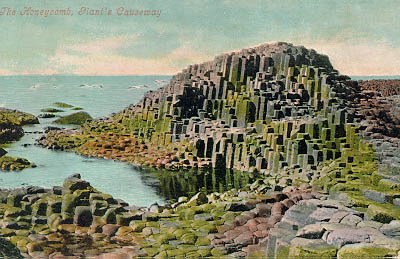
Columnar jointing forms in lava flows, sills, dikes, ignimbrites (ashflow tuffs), and shallow intrusions of all compositions. Most columns are straight with parallel sides and diameters from a few centimeters to 3 m. Some columns are curved and vary in width. Columns can reach heights of 30 m.
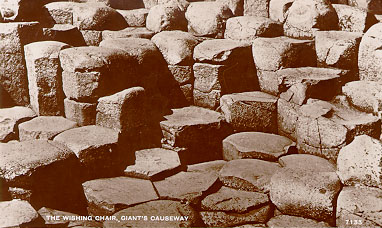
Most columns tend to have 5 or 6 sides but have as few as 3 and as many as 7 sides.
The columns may form sets. Straight, regular columns are called colonnade. Irregular, fractures columns are called entablature.
From Spry (1962).
The columns form due to stress as the lava cools (Mallet, 1875; Iddings, 1886, 1909; Spry, 1962). The lava contracts as it cools, forming cracks. Once the crack develops it continues to grow. The growth is perpendicular to the surface of the flow. Entablature is probably the result of cooling caused by fresh lava being covered by water. The flood basalts probably damned rivers. When the rivers returned the water seeped down the cracks in the cooling lava and caused rapid cooling from the surface downward (Long and Wood, 1986). The division of colonnade and entablature is the result of slow cooling from the base upward and rapid cooling from the top downward.
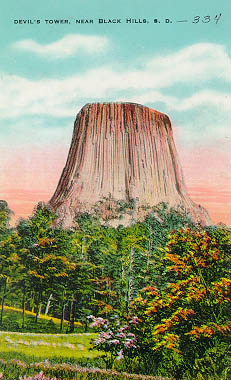
Possible mechanism for the formation of columnar jointing at Devils Tower. Isotherms are layers with the same temperature. Joints formed perpendicular to the isotherms as the rock cooled. From Spry (1962).
In 1804, Watts suggested that "molten magma solidified around a series of isolated centres to form large plastic balls, which when pressed together gave the typical hexagonal symmetry" (Spry, 1962). In 1916, Sosman proposed that the columns are the results of a system of hexagonal convection cells. Sosman's model was based on experiments of wax or oil in a flat dish. Critics noted that lava flows do not gain heat from their bases but actually lose heat from the top surface. Furthermore, the shape of the convection cells did not resemble hexagonal columns.

Large columnar joints that developed in a cooling lava pond in Mokaopuhi Crater, East Rift Zone, Kilauea. The columns were exposed by a younger episode of collapse of the pit crater. An even younger eruption has buried these spectacular columns.
Photo courtesy of the U.S. Geological Survey.
There are more than 40,000 columns at Giants Causeway. German composer Felix Mendelssohn based his famous 1830 "Hebrides Overture" on the sound of the waves filling and draining Fingals Cave. The similarity of the shape of the columns to those of quartz crystals was once used to support the theory (called Neptunism) that volcanic rocks precipitated from water.
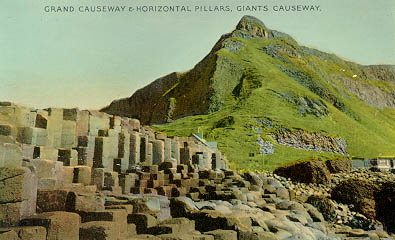
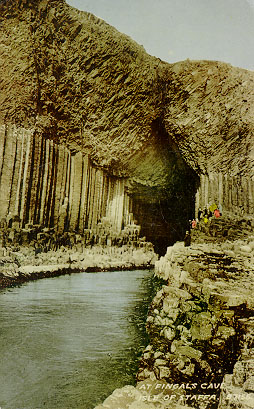
Irish Folklore for the Origin of Giants Causeway and Fingals Cave: Finn Mac Cool, an Irish Giant, wanted to fight his Scottish counterpart, Finn Gall. Mac Cool drove the columns in place, one at a time, until the causeway reached Scotland (Fingals Cave). Mac Cool was so tired from the hard work that he returned home to rest. Finn Gall followed the causeway to Ireland. He found Mac Cool sleeping and Mac Cool's wife, a very shrewd woman, told Finn Gall that this was her baby sleeping. Finn Gall grew alarmed, thinking this giant baby's father must be of incredible size and that he would surely lose any fight. Finn Gall fled back to Scotland. As he did, he destroyed the causeway. Only the two ends of the causeway survive to this day.
Beard, C.N., 1959, Quantitative study of columnar jointing: Journal of the Geological Society of America, v. 70, p. 379-381.
Billings, M.P., 1954, Structural geology: Prentice Hall, N.Y., 514 p.
Geikie, A., 1897, Ancient volcanoes of Great Britain, vol. 2: Macmillan, London.
Hartesveldt, R.J., 1952, The geologic story of the Devils Postpile: Yosemite Nature Notes, v. 31, p. 140-149.
Hunt, C.B., 1937, Igneous geology and structure of the Mt. Taylor field: U.S. Geological Survey Professional Paper 189B.
Hunt, C.B., 1938, Suggested explanation for the curvature of columnar joints in volcanic necks: American Journal of Science, v. 236, p. 161-171.
Iddings, J.P., 1886, Columnar structure in the igneous rocks of orange Mtn., N.J.: American Journal of Science, v. 131, p. 321-330.
Iddings, J.P., 1909, Igneous Rocks: Wiley, New York.
James, A.V.G., 1920, Factors producing columnar structures in lavas and its occurrence near Melbourne, Australia: J. Geol., v. 28, p. 458-469.
Judd, J.W., 1881, Volcanoes: London.
Long, P.E., and Wood, B.J., 1986, Structures, textures, and cooling histories of Columbia River basalt flows: Geol. Soc. America Bull., v. 97, p. 1144-1155.
Mackin, J.H., 1961, A stratigraphic section in the Yakima basalt in south-central Washington: Rep. Of Investigations No. 19, Div. Mines and Geol., State of Washington.
Mallet, R., 1875, Origin and mechanism of production of prismatic (or Columnar) structure in basalt: Phil. Mag. v. 4, p. 122-135 and 201-226.
Matthews, W.H., 1951, The table, a flat-topped volcano in southern British Columbia: American Journal of Science, v. 249, p. 830-841.
Rohleder, H.P.T., 1929, Geological guide to the Giants Causeway and the north coast of Antrim: Belfast, Wm. Sweeney, 32 p.
Scrope, G.P., Volcanoes: London.
Sosman, R.B., 1916, Types of prismatic structures in igneous Rocks: J. Geol., v. 24, p. 215-234.
Spry, A., 1962, The origin of columnar jointing, particularly in basalt flows: Journal of the Australian Geological Society, v. 8, p. 192-216.
Tomkieff, S.T., 1940, Basalt lavas of the Giants Causeway: Bulletin of Volcanology, v. 6, p. 89-143.
Waters, A.C., 1960, Determining directions of flow in basaltic lava flows: American Journal of Science, Bradley Vol., v. 258A, p. 350-366.